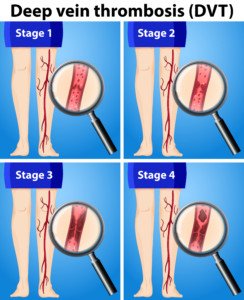Here Are Some Great Blood Clot (DVT) and Pulmonary Embolism (PE) Articles.
The vast majority of pulmonary emboli originate from a deep vein thrombosis.
A piece of the DVT may break off and get into the general circulation — a possible life-threatening situation.
“When the clot lodges in the lung, it cuts off blood flow to a portion of the lung — preventing the oxygen you breathe from transferring into the bloodstream,” explains Christopher J. Hanifin, PA-C, who was previously a physician assistant in open heart surgery with Cardiothoracic Surgery of South Bend in South Bend, IN.
“PE can have very serious consequences, so clinicians must always include it among the diagnoses considered when a patient complains of chest pain,” continues Hanifin.
“A careful history is obtained to try to identify any factors that may predispose a patient toward developing blood clots.
“A scoring system has been developed to help assist clinicians in identifying patients at high risk. Patients with elevated risk undergo further testing” such as a CT scan of the chest.
DVT Calve Pain vs. Pulled Muscle Calve Pain
You’ve probably read that one of the symptoms of a DVT is a calve cramp. But a calve cramp is also a symptom of a pulled or strained calve muscle.

Source: vecteezy.com
What makes this even trickier is that sometimes, a DVT may present with only the pain.
Is there a way to tell the difference between deep vein thrombosis cramping and the cramping of a pulled muscle? More…
…..
DVT Risk and Air Travel: Truth or Hype?
Can it really be that dangerous to sit for long periods on an airplane?
The DVT danger of prolonged sitting during travel is NOT hype. Continue reading…
…..
Are you a tall woman?
Your DVT risk on airplanes may be higher than that for shorter women. Read more…
…..
Are thigh high surgical stockings better than knee high for blood clot prevention?
The trend now seems in favor of knee high surgical stockings. Why are the thigh highs going by the wayside? More…
…..
Are you a runner? Have a DVT?

How safe—or not—is it to go for a jog if you have a deep vein thrombosis in your calve? Read more.
…..
The test that detects a DVT in the legs after surgery: why you should ask about it.
Though a DVT can form in the legs after (or during) surgery and quickly move into the lungs and become a fatal pulmonary embolism, it’s not routine for medical staff to give a DVT-detecting test following surgery, and only about one in five hospitals has this technology. Do you know if YOUR hospital does? Continue reading…
…..
Nonsmoker but take birth control pills? Should you worry about blood clot risk?
You’ve certainly heard that smoking raises blood clot risk for women on birth control pills. But how much of a risk do the pills create in women who don’t smoke? Continue reading…
…..
Can aspirin alone help prevent a DVT?
You know that aspirin is a blood thinner. So how effective is it at protecting against DVT? Read more…
…..
Why does a DVT form during surgery?
After all, we’re immobile for hours on end during regular sleep, too! Continue reading…
…..
Pulmonary Embolism Prevention after Joint Replacement Surgery
Think that powerful blood thinners are your best bet for fighting pulmonary embolism after joint replacement surgery?
A review of 20 studies has some surprising results. Continue reading…
 Christopher J. Hanifin, PA-C, is currently Department Chair and Assistant Professor, Department of Physician Assistant, Seton Hall University
Christopher J. Hanifin, PA-C, is currently Department Chair and Assistant Professor, Department of Physician Assistant, Seton Hall University
 Lorra Garrick has been covering medical, fitness and cybersecurity topics for many years, having written thousands of articles for print magazines and websites, including as a ghostwriter. She’s also a former ACE-certified personal trainer.
Lorra Garrick has been covering medical, fitness and cybersecurity topics for many years, having written thousands of articles for print magazines and websites, including as a ghostwriter. She’s also a former ACE-certified personal trainer.
.



























